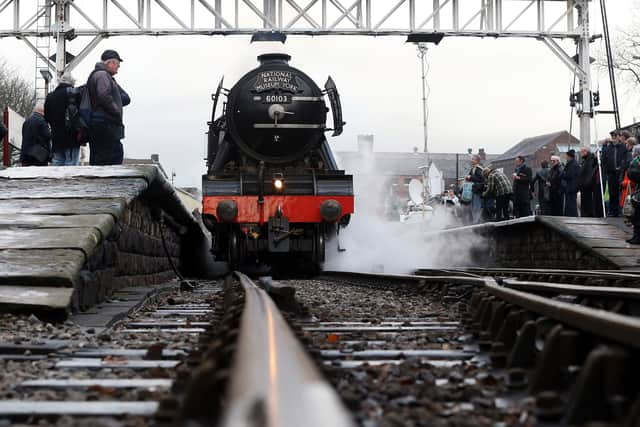Flying Scotsman crash: what happened in Aviemore train accident - and Strathspey Railway collision explained
and live on Freeview channel 276
The iconic Flying Scotsman steam locomotive is to undergo a complete mechanical inspection following a low speed crash.
The century-old steam train was involved in a "shunting incident" on Friday (29 September) at the Aviemore Railway Station close to Inverness.
Advertisement
Hide AdAdvertisement
Hide AdTwo people were treated in a hospital "as a precaution," and an investigation was launched after emergency services arrived at the scene shortly after 7pm.
The world-famous steam train - owned by the National Railway Museum in York and celebrating its centenary year.- was scheduled to take tourists on trips at the weekend, which had to be postponed.
The crash was described as a “particularly difficult situation” by heritage line The Strathspey Railway. A statement said the inspection was “the earliest the owners can achieve”.
Eight appliances from the Scottish Fire and Rescue Service went to the scene, along with officers from Police Scotland.
Advertisement
Hide AdAdvertisement
Hide AdA Police Scotland spokesperson said: “Police inquiries have concluded following a low-speed train collision at Aviemore railway station on Friday 29 September. There was no criminality and the matter has been referred to the Rail Accident Investigation Branch.”


A statement from the Belmond and Strathspey Railway about the incident on Friday evening said: “A shunting incident occurred when the Flying Scotsman locomotive was being coupled with Belmond’s Royal Scotsman train carriages, which were stationary on heritage railway line, Strathspey Railway.
"Flying Scotsman was visiting the railway as part of a planned excursion.”
The Flying Scotsman is often considered one of the most iconic and recognisable locomotives in the world. It was originally built in 1923 for the London and North Eastern Railway (LNER), and was designed by Sir Nigel Gresley, one of the country's renowned locomotive engineers.
Advertisement
Hide AdAdvertisement
Hide AdIt earned its fame primarily for its long-distance express passenger services, particularly the London to Edinburgh route, which it served for many years. It was the first steam locomotive to officially reach a speed of 100 miles per hour in passenger service in 1934.
The locomotive was also known for its distinctive livery, initially in apple green and later in British Railways' Brunswick green. It became a symbol of British engineering and railway heritage, often associated with the golden age of steam locomotion.
In 1963, the Flying Scotsman was retired from regular service and was subsequently preserved. It changed ownership several times over the years, and there were periods when it was in the hands of private collectors and enthusiasts. It has undergone extensive restoration efforts during its preservation period.
It continues to operate on heritage railways and occasionally undertakes special runs, allowing people to experience the thrill of travelling behind the famous locomotive, and has also made various appearances in films, documentaries and at special events.
Comment Guidelines
National World encourages reader discussion on our stories. User feedback, insights and back-and-forth exchanges add a rich layer of context to reporting. Please review our Community Guidelines before commenting.
